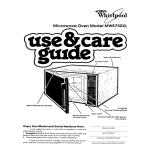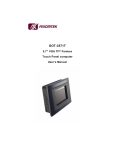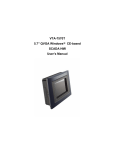Download GOT-5100TL All-in-One 10.4” SVGA TFT Super Slim
Transcript
GOT-5100TL All-in-One 10.4” SVGA TFT Super Slim Fanless Toudh Computer User’s Manual Disclaimers This manual has been carefully checked and believed to contain accurate information. AXIOMTEK Co., Ltd. assumes no responsibility for any infringements of patents or any third party’s rights, and any liability arising from such use. AXIOMTEK does not warrant or assume any legal liability or responsibility for the accuracy, completeness or usefulness of any information in this document. AXIOMTEK does not make any commitment to update the information in this manual. AXIOMTEK reserves the right to change or revise this document and/or product at any time without notice. No part of this document may be reproduced, stored in a retrieval system, or transmitted, in any form or by any means, electronic, mechanical, photocopying, recording, or otherwise, without the prior written permission of AXIOMTEK Co., Ltd. Copyright 2009 AXIOMTEK Co., Ltd. All Rights Reserved April 2009, Version A3 Printed in Taiwan ii Safety Approvals u CE Marking u FCC Class A u FCC Compliance This equipment has been tested in compliance with the limits for a Class A digital device, pursuant to Part 15 of the FCC Rules. These limits are meant to provide reasonable protection against harmful interference in a residential installation. If not installed and used in accordance with proper instructions, this equipment might generate or radiate radio frequency energy and cause harmful interference to radio communications. However, there is no guarantee that interference will not occur in a particular installation. If this equipment does cause harmful interference to radio or television reception, which can be determined by turning the equipment off and on, the user is encouraged to try to correct the interference by one or more of the following methods: 1. Reorient or relocate the receiving antenna. 2. Increase the separation between the equipment and receiver. 3. Connect the equipment to another outlet of a circuit that doesn’t connect with the receiver. 4. Consult the dealer or an experienced radio/TV technician for help. Shielded interface cables must be used in order to comply with the emission limits. iii Safety Precautions Before getting started, please read the following important safety precautions. 1. 2. 3. 4. 5. 6. 7. 8. iv The GOT-5100TL does not come equipped with an operating system. An operating system must be loaded first before installing any software into the computer. Be sure to ground yourself to prevent static charge when installing the internal components. Use a grounding wrist strap and place all electronic components in any staticshielded devices. Most electronic components are sensitive to static electrical charge. Disconnect the power cord from the GOT-5100TL before any installation. Be sure both the system and external devices are turned OFF. A sudden surge of power could ruin sensitive components that the GOT-5100TL must be properly grounded. The brightness of the flat panel display will be getting weaker as a result of frequent usage. However, the operating period varies depending on the application environment. Turn OFF the system power before cleaning. Clean the system using a cloth only. Do not spray any liquid cleaner directly onto the screen. The GOT-5100TL may come with or w/o a touchscreen. Although the touchscreen is chemical resistant, it is recommended that you spray the liquid cleaner on a cloth first before wiping the screen. In case your system comes without the touchscreen, you must follow the same procedure and not spray any cleaner on the flat panel directly. Avoid using sharp objects to operate the touchscreen. Scratches on the touchscreen may cause malfunction or internal failure to the touchscreen. The flat panel display is not susceptible to shock or vibration. When assembling the GOT-5100TL, make sure it is securely installed. Do not open the system’s back cover. If opening the cover for maintenance is a must, only a trained technician is allowed to do so. Integrated circuits on computer boards are sensitive to static electricity. To avoid damaging chips from electrostatic discharge, observe the following precautions: l l Before handling a board or integrated circuit, touch an unpainted portion of the system unit chassis for a few seconds. This will help to discharge any static electricity on your body. When handling boards and components, wear a wristgrounding strap, available from most electronic component stores. Trademarks Acknowledgments AXIOMTEK is a trademark of AXIOMTEK Co., Ltd. IBM, PC/AT, PS/2, VGA are trademarks of International Business Machines Corporation. ® ® Intel and Pentium are registered trademarks of Intel Corporation. MS-DOS, Microsoft C and Quick BASIC are trademarks of Microsoft Corporation. VIA is a trademark of VIA Technologies, Inc. SST is a trademark of Silicon Storage Technology, Inc. UMC is a trademark of United Microelectronics Corporation. Other brand names and trademarks are the properties and registered brands of their respective owners. v Table of Contents Disclaimers.................................................................................... ii Safety Approvals ...........................................................................iii Safety Precautions ....................................................................... iv CHAPTER 1 INTRODUCTION ..........................................................1 1.1 General Description.....................................................1 1.2 Specifications ..............................................................2 1.2.1 Main CPU Board..........................................................2 1.2.2 I/O System ..................................................................3 1.2.3 System Specification ..................................................3 1.3 Dimensions..................................................................5 1.4 I/O Outlets ...................................................................6 1.5 Packing List .................................................................7 CHAPTER 2 HARDWARE INSTALLATION ......................................8 2.1 CF card Installation......................................................8 2.2 Serial Ports Interface .................................................10 2.3 Ethernet .....................................................................12 2.4 Mountings – Panel/Wall/Desktop/VESA....................13 2.4.1 Panel Mounting.........................................................13 2.4.2 Wall-Mounting...........................................................14 2.4.3 Desktop-Mounting ....................................................15 2.4.4 VESA-ARM Mounting ...............................................17 2.5 HDD Installation.........................................................19 2.6 Wireless Card Installation..........................................21 CHPATER 3 PHOENIX-AWARD BIOS UTILITY .............................24 3.1 Entering Setup ...........................................................24 3.2 Control Keys ..............................................................25 3.3 Getting Help...............................................................25 3.4 The Main Menu..........................................................26 3.5 Standard CMOS Setup Menu....................................27 3.6 Advanced BIOS Features..........................................29 3.7 Advanced Chipset Features ......................................32 3.8 Integrated Peripherals ...............................................33 3.9 Power Management Setup ........................................38 3.10 PnP/PCI Configuration Setup ....................................40 3.11 PC Health Status .......................................................42 3.12 Load Optimized Defaults ...........................................43 vi 3.13 3.14 3.15 Set Supervisor/User Password..................................44 Save & Exit Setup......................................................45 Exit Without Saving ...................................................46 CHAPTER 4 DRIVERS INSTALLATION..........................................47 4.1 System.......................................................................47 4.2 Touch Screen ............................................................48 4.2.1 Specification (GOT-5100TL) .....................................48 4.2.2 Driver Installation- Windows XP ................................48 4.3 Embedded O.S. .........................................................51 4.3.1 Windows XP Embedded............................................51 4.3.2 Windows CE.NET 5.0................................................52 Appendix...........................................................................................53 vii MEMO viii GOT-5100TL User’s Manual CHAPTER 1 INTRODUCTION This chapter contains general information and detailed specifications of the GOT-5100TL. Chapter 1 includes the following sections: n n n n n 1.1 General Description Specification Dimensions I/O Outlets Package List General Description The GOT-5100TL is a fan-less and compact-size touch panel computer, equipped with an 10.4” TFT LCD display and low power consumption AMD LX800 processor with FSB 500MHz. The GOT® ® ® 5100TL supports Windows XP, Windows CE.NET and Windows XP embedded. The panel is able to install a CompactFlash™ card and provide a MiniPCI slot for wireless module. l Ø GOT-5100TL: 10.4” TFT SVGA Fanless Touch Panel Computer Reliable and Stable Design The GOT-5100TL adopts a fan-less cooling system and a CompactFlash™ card, which makes it especially suitable for vibration-heavy environments, best for the transportation, shipping and industrial machinery markets. Introduction 1 GOT-5100TL User’s Manual Ø Embedded O.S. Supported ® The GOT-5100TL not only supports Windows XP, but also ® supports embedded OS, such as Windows CE.NET, and ® Windows XP embedded. For storage device, the GOT-5100TL supports CompactFlash™ card. Ø Industrial-grade Product Design The GOT-5100TL has an incredible design to be used in different industrial harsh environments. l A fuse helps prevent over-voltage for power input. l The front bezel meets the IP65/NEMA4 standard. l For connecting other devices, the GOT-5100TL also features several interfaces: USB, Ethernet, and RS-232/422/485. 1.2 Specifications 1.2.1 Main CPU Board l CPU n l AMD LX800 processor 500 MHz onboard System Chipset n AMD LX + CS5536AD BIOS l n Phoenix-Award BIOS, 4Mbit with RPL/PXE LAN boot ROM, SmartView and customer CMOS Backup System Memory l 2 n One 200-pin DDR DIMM socket n Maximum memory up to 1GB Introduction GOT-5100TL User’s Manual 1.2.2 l l I/O System Standard I/O n One RS-232 and one RS-232/422/485 n Two USB 2.0 Ethernet n l Audio n l One Mini-PCI Storage n l Line-out Expansion n l One RTL8139DL Fast Ethernet One slot for CF card Box-header n 1.2.3 One PATA-100 IDE System Specification l 10.4” TFT LCD l Heat Dispensing Design l Disk drive housing: n l Net Weight n l 1.6 Kgs (3.52 lb) Dimension (Main Body Size) n l one 2.5” PATA drive (option) 293x 44.6 x 236mm Operation Temperature n 0℃to 45℃ l Relative Humidity n 10% to 90% @ 40℃, Non-Condensing l Vibration (Operating) n TM 5 to 500 Hz, 2.0 G random for CompactFlash Introduction 3 GOT-5100TL User’s Manual NOTE All specifications and images are subject to change without notice. 4 Introduction GOT-5100TL User’s Manual 1.3 Dimensions This diagram shows you dimensions and outlines of the GOT-5100TL. Introduction 5 GOT-5100TL User’s Manual 1.4 I/O Outlets Please refer to the following illustration for I/O locations of the GOT5100TL. No 6 Function 1 POWER SWITCH (AT) 2 24VDC POWER 3 VGA 4 COM 2 (RS-232) 5 COM 1 (RS-232/422/485) 6 1 X ETHERNET (RJ-45) 7 2 X USB 2.0 8 AUDIO (LINE-OUT) Introduction GOT-5100TL User’s Manual 1.5 Packing List When you receive the GOT-5100TL, the bundled package should contain the following items: l l l l l l l l GOT-5100TL x 1 Panel Mount Kit x 6 Driver CD x1 Wall-Mount Kit x1 Wireless LAN kit (optional) 2.5” HDD kit (optional) Desktop Stand Kit (optional) VESA ARM(optional) If you have any demand for the optional items or any items are missing, please contact AXIOMTEK distributors immediately. Introduction 7 GOT-5100TL User’s Manual CHAPTER 2 HARDWARE INSTALLATION The GOT-5100TL provides rich I/O ports and flexible expansions for you to meet different demand, for example, CF card. The chapter will show you how to install the hardware. It includes: n n n n 2.1 CompactFlash™ Card Serial Port Ethernet Mounting Way CF card Installation The GOT-5100TL provides one CF slot for users to install CompactFlash™ card. Please refer to the following instructions for installation: Step 1 8 Turn off the system, and unplug the power cord. Hardware Installation GOT-5100TL User’s Manual Step 2 Find out the cover on the side of the system. Step 3 Locate the CompactFlash the socket. Hardware Installation TM socket, and insert the card into 9 GOT-5100TL User’s Manual 2.2 Serial Ports Interface The GOT-5100TL has two onboard serial ports, COM1 (RS232/422/485) and COM2 (RS-232). The following table shows you the pin assignments of this connector: Pin Signal Pin Signal 1 Data Carrier Detect (DCD) 6 Data Set Ready (DSR) 2 Receive Data (RXD) 7 Request To Send (RTS) 3 Transmit Data (TXD) 8 Clear To Send (CTS) 4 Data Terminal Ready (DTR) 9 Ring Indicator (RI) 5 Ground (GND) In addition, COM1 can be set for RS-232/422/485 by jumper. The jump setting is listed as below: COM1 10 JP10 JP11 JP12 RS-232 (default) 3-5, 4-6 3-5, 4-6 1-2 RS-422 1-3, 2-4 1-3, 2-4 3-4, 7-8 RS-485 1-3, 2-4 1-3, 2-4 5-6, 7-8 Hardware Installation GOT-5100TL User’s Manual COM2 COM1 When COM1 is set to RS-422 or RS-485, the pin assignments are listed below: Pin # Signal Name RS-422 RS-485 1 TX- DATA- 2 TX+ DATA+ 3 RX+ No connector 4 RX- No connector 5 No connector No connector 6 No connector No connector 7 No connector No connector 8 No connector No connector 9 GND GND Hardware Installation 11 GOT-5100TL User’s Manual 2.3 Ethernet The GOT-5100TL is equipped with a high performance Plug and Play Ethernet interface, full compliant with IEEE 802.3 standard, and can be connected with a RJ-45 LAN connector. Please refer to detailed pin assignment list below: Pin Signal 1 TX+ (Data transmission positive 2 TX- (Data transmission negative) 3 Rx+(Data reception positive) 4 RJ45 termination 5 RJ45 termination 6 Rx- (Data reception negative) 7 RJ45 termination 8 RJ45 termination 12 1 2 3 4 5 6 7 8 RJ-45 Hardware Installation GOT-5100TL User’s Manual 2.4 Mountings – Panel/Wall/Desktop/VESA There are several mounting ways for the GOT-5100TL, Panel, Wall, Desktop and VESA mountings. 2.4.1 Panel Mounting The GOT-5100TL is designed for panel mount application. A set of standard mounting kit are bundled with the system package that you can use it to mount the GOT-5100TL. Hardware Installation 13 GOT-5100TL User’s Manual 2.4.2 Wall-Mounting The GOT-5100TL is designed for Wall mounting application. Please refer to the following steps: Find out the screws as marked on the back side of chassis. 14 Hardware Installation GOT-5100TL User’s Manual 2.4.3 Desktop-Mounting The GOT-5100TL is designed for desktop mounting application. Please refer to the following steps: Step 1 Find out the screws as marked on the back side of chassis. Hardware Installation 15 GOT-5100TL User’s Manual Step 2 16 Assemble the desktop stand to the chassis, and fix the screws. Hardware Installation GOT-5100TL User’s Manual 2.4.4 VESA-ARM Mounting Step 1 Find out the screws as marked on the back side of chassis. Step 2 Assemble the VESA-ARM to the back side of the chassis, and fix the screws. Hardware Installation 17 GOT-5100TL User’s Manual Step 3 18 VESA mounting Installation completed. Hardware Installation GOT-5100TL User’s Manual 2.5 HDD Installation The GOT-5100TL provides a convenient drive bay module for users to install 2.5” IDE HDD. Please follow the steps: 1. Unscrew screws to remove the rear chassis. 2. Unscrew 4 screws from the HDD drive bracket, and take out HDD bracket kit to install 2.5” HDD. Hardware Installation 19 GOT-5100TL User’s Manual 3. Installation complete. 20 Hardware Installation GOT-5100TL User’s Manual 2.6 Wireless Card Installation The GOT-5100TL provides one miniPCI slot for user to install one wireless card. W hen installing the wireless card, refer to the following instructions and illustration: 1. Open the back cover and find mainboard (EP621). 2. Install miniPCI wireless card. Hardware Installation 21 GOT-5100TL User’s Manual 3. There are two connectors on wireless LAN card. One is MAIN, and the other is AUX. Connect antenna cable to MAIN connector on wireless LAN card. 22 Hardware Installation GOT-5100TL User’s Manual MEMO Hardware Installation 23 GOT-5100TL User’s Manual CHPATER 3 PHOENIX-AWARD BIOS UTILITY The Phoenix-Award BIOS provides users with a built-in Setup program to modify basic system configuration. All configured parameters are stored in a battery-backed-up RAM (CMOS RAM) to save the Setup information whenever the power is turned off. 3.1 Entering Setup There are two ways to enter the Setup program. You may either turn ON the computer and press <Del> immediately, or press the <Del> and/or <Ctrl>, <Alt>, and <Esc> keys simultaneously when the following message appears at the bottom of the screen during POST (Power on Self Test). TO ENTER SETUP PRESS DEL KEY If the message disappears before you respond and you still want to enter Setup, please restart the system to try it again. Turning the system power OFF and ON, pressing the “RESET” button on the system case or simultaneously pressing <Ctrl>, <Alt>, and <Del> keys can restart the system. If you do not press keys at the right time and the system doesn’t boot, an error message will pop out to prompt you the following information: PRESS <F1> TO CONTINUE, <CTRL-ALT-ESC> OR <DEL> TO ENTER SETUP 24 Phoenix-Award BIOS Utility GOT-5100TL User’s Manual 3.2 Control Keys Up arrow Move cursor to the previous item Down arrow Move cursor to the next item Left arrow Move cursor to the item on the left hand Right arrow Move to the item in the right hand Esc key PgUp/“+” key Main Menu -- Quit and delete changes into CMOS Status Page Setup Menu and Option Page Setup Menu -- Exit current page and return to Main Menu Increase the numeric value or make changes PgDn/“−“ key Decrease the numeric value or make changes F3 key General help, only for Status Page Setup Menu and Option Page Setup Menu Change color from total 16 colors. F2 to select color forward, (Shift) F2 to select color backward Reserved F4 key Reserved F1 key (Shift) F2 key F8 key Restore the previous CMOS value from CMOS, only for Option Page Setup Menu Load the default CMOS value from BIOS default table, only for Option Page Setup Menu Load the Setup default, only for Option Page Setup Menu Reserved F9 key Reserved F10 key Save all the CMOS changes, only for Main Menu F5 key F6 key F7 key 3.3 Getting Help l Main Menu The online description of the highlighted setup function is displayed at the bottom of the screen. l Status Page Setup Menu/Option Page Setup Menu Press <F1> to pop out a small Help window that provides the description of using appropriate keys and possible selections for highlighted items. Press <F1> or <Esc> to exit the Help Window. Phoenix-Award BIOS Utility 25 GOT-5100TL User’s Manual 3.4 The Main Menu Once you enter the Award BIOS CMOS Setup Utility, the Main Menu appears on the screen. In the Main Menu, there are several Setup functions and a couple of Exit options for your selection. Use arrow keys to select the Setup Page you intend to configure then press <Enter> to accept or enter its sub-menu. NOTE If your computer can not boot after making and saving system changes with Setup, the Award BIOS will reset your system to the CMOS default settings via its built-in override feature. It is strongly recommended that you should avoid changing the chipset’s defaults. Both Award and your system manufacturer have carefully set up these defaults that provide the best performance and reliability. 26 Phoenix-Award BIOS Utility GOT-5100TL User’s Manual 3.5 Standard CMOS Setup Menu The Standard CMOS Setup Menu displays basic information about your system. Use arrow keys to highlight each item, and use <PgUp> or <PgDn> key to select the value you want in each item. l Date The date format is <day>, <date> <month> <year>. Press <F3> to show the calendar. day It is determined by the BIOS and read only, from Sunday to Saturday. date It can be keyed with the numerical/ function key, from 1 to 31. month It is from January to December. year It shows the current year of BIOS. l Time This item shows current time of your system with the format <hour> <minute> <second>. The time is calculated based on the 24-hour military-time clock. For example, 1 p.m. is 13:00:00. l IDE Primary Master/Primary Slave These items identify the types of each IDE channel installed in the Phoenix-Award BIOS Utility 27 GOT-5100TL User’s Manual computer. There are 45 predefined types (Type 1 to Type 45) and 2 user’s definable types (Type User) for Enhanced IDE BIOS. Press <PgUp>/<+> or <PgDn>/<−> to select a numbered hard disk type, or directly type the number and press <Enter>. Please be noted your drive’s specifications must match the drive table. The hard disk will not work properly if you enter improper information. If your hard disk drive type does not match or is not listed, you can use Type User to manually define your own drive type. If selecting Type User, you will be asked to enter related information in the following items. Directly key in the information and press <Enter>. This information should be provided in the documentation from your hard disk vendor or the system manufacturer. If the HDD interface controller supports ESDI, select “Type 1”. If the HDD interface controller supports SCSI, select “None”. If the HDD interface controller supports CD-ROM, select “None”. CYLS. HEADS number of cylinders number of heads PRECOMP write precom LANDZONE landing zone SECTORS number of sectors MODE HDD access mode If there is no hard disk drive installed, select NONE and press <Enter>. l Video Select the display adapter type for your system. l Halt On This item determines whether the system will halt or not, if an error is detected while powering up. No errors The system booting will halt on any errors detected. (default) All errors Whenever BIOS detects a non-fatal error, the system will stop and you will be prompted. All, But Keyboard The system booting will not stop for a keyboard error; it will stop for other errors. All, But Diskette The system booting will not stop for a disk error; it will stop for other errors. All, But Disk/Key The system booting will not stop for a keyboard or disk error; it will stop for other errors. Press <Esc> to return to the Main Menu page. 28 Phoenix-Award BIOS Utility GOT-5100TL User’s Manual 3.6 Advanced BIOS Features This section allows you to configure and improve your system, to set up some system features according to your preference. l First/Second/Third Boot Device st nd rd These items let you select the 1 , 2 , and 3 devices that the system will search for during its boot-up sequence. The wide range of selection includes USB-CDROM, HDD-0, HDD-1, and so on. l Boot Other Device This item allows users to enable or disable the boot device not listed in the First/Second/Third boot devices option above. The default setting is “Enabled”. l Boot Up NumLock Status Set the Num Lock status when the system is powered on. The default value is “On”. Phoenix-Award BIOS Utility 29 GOT-5100TL User’s Manual l Gate A20 Option The default value is “Fast”. Normal The A20 signal is controlled by keyboard controller or chipset hardware. Fast Default: Fast. The A20 signal is controlled by Port 92 or chipset specific method. l Typematic Rate Setting This item determines the typematic rate of the keyboard. The default value is “Disabled”. Enabled Disabled Enable typematic rate and typematic delay programming. Disable typematic rate and typematic delay programming. The system BIOS will use default value of these 2 items, controlled by keyboard. l Typematic Rate (Chars/Sec) This option refers to character numbers typed per second by the keyboard. The function is always 6 characters per second. l Typematic Delay (Msec) This option defines how many milliseconds must elapse before a held-down key begins generating repeat characters. The function is always 250 msec. l Security Option This item allows you to limit access to the system and Setup, or just to Setup. The default value is “Setup”. System If a wrong password is entered at the prompt, the system will not boot, the access to Setup will be denied, either. Setup If a wrong password is entered at the prompt, the system will boot, but the access to Setup will be denied. NOTE To disable the security, select PASSWORD SETTING at Main Menu and then you will be asked to enter a password. Do not type anything, just press <Enter> and it will disable the security. Once the security is disabled, the system will boot and you can enter Setup freely. 30 Phoenix-Award BIOS Utility GOT-5100TL User’s Manual l Small Logo(EPA) Show If enabled, the EPA logo will appear during system booting up; if disabled, the EPA logo will not appear. Press <Esc> to return to the Main Menu page. Phoenix-Award BIOS Utility 31 GOT-5100TL User’s Manual 3.7 Advanced Chipset Features This section contains completely optimized chipset’s features on the board that you are strongly recommended to leave all items on this page at their default values unless you are very familiar with the technical specifications of your system hardware. l CPU Frequency Use this item to set the CPU Frequency with these options: Auto, 333MHz, 400MHz, 433MHz and 500MHz. The default setting is “Auto”. l Memory Frequency This item helps you set main memory frequency. When using an external graphics card, it can be adjusted to enable the best performance for your system. l CAS Latency Time You can select CAS latency time to HCLKs 2, 3, or Auto. The board designer should have set up these values in accordance with the installed DRAM. Do not change these values unless you have to change the specifications of the installed DRAM or CPU. l Video Memory Size The available options are “8M”, “16M”, “32M”, “64M”, “128M” and “254M”. 32 Phoenix-Award BIOS Utility GOT-5100TL User’s Manual l Output Display This item allows you to choose the output for your system display. Configuration options are “CRT”, “Flat Panel” and “Panel & CRT”. The default value is “Panel & CRT”. l Flat Panel Configuration The configuration is for resolution of flat panel which locks to 800 × 600. Press <Esc> twice to return to the Main Menu page. 3.8 Integrated Peripherals This section allows you to configure your SuperIO Device, IDE Function and Onboard Device. Phoenix-Award BIOS Utility 33 GOT-5100TL User’s Manual l Super IO Device Scroll to this item and press <Enter> to view the sub menu Super IO Device. Ø Onboard Serial Port 1/2/3 Select an address and corresponding interrupt for the serial port. Options: 3F8/IRQ4, 2F8/IRQ3, 3E8/IRQ10, 2E8/IRQ11, 338/IRQ5, 238/IRQ7, Auto and Disabled. Press <Esc> to return to the Integrated Peripherals page. 34 Phoenix-Award BIOS Utility GOT-5100TL User’s Manual l IDE Function Setup Scroll to this item and press <Enter> to view the sub menu IDE Function Setup. Ø Ø Ø Ø Master/Slave Drive PIO Mode The four IDE PIO (Programmed Input/Output) fields let you set a PIO mode (0-4) for each of the four IDE devices that the onboard IDE interface supports. Modes 0 to 4 provide successively increased performance. In Auto mode, the system automatically determines the best mode for each device. IDE Primary/Secondary Master/Slave UDMA Select the mode of operation for the IDE drive. Ultra DMA33/66/100/133 implementation is possible only if your IDE hard drive supports it and the operating environment includes a DMA driver. If the hard drive and system software both support Ultra DMA-33/66/100/133, select Auto to enable UDMA mode by BIOS. IDE DMA transfer access Automatic data transfer between system memory and IDE device with minimum CPU intervention. This improves data throughput and frees CPU to perform other tasks. IDE HDD Block Mode Block mode is also called block transfer, multiple commands, or multiple sectors read/write. If your IDE hard drive supports Phoenix-Award BIOS Utility 35 GOT-5100TL User’s Manual block mode (most new drives do), select Enabled for automatic detection of the optimal number of block read/writes per sector the drive can support. Press <Esc> to return to the Integrated Peripherals page. l Onboard Device Scroll to this item and press <Enter> to view the sub menu Onboard Device. Ø Ø Ø Ø Onboard Audio Use this item to enable or disable the onboard Audio function. Onboard USB1.1 Enable this item if you are using the EHCI (USB1.1) controller in the system. Onboard USB 2.0 Enable this item if you are using the EHCI (USB2.0) controller in the system. Onboard Lan Boot ROM Use this item to enable or disable the Boot ROM function of the onboard LAN chip when the system boots up. Press <Esc> to return to the Integrated Peripherals page. 36 Phoenix-Award BIOS Utility GOT-5100TL User’s Manual l ITE8888 Configure Scroll to this item and press <Enter> to view the sub menu ITE8888 Configure. Press <Esc> twice to return to the Main Menu page. Phoenix-Award BIOS Utility 37 GOT-5100TL User’s Manual 3.9 Power Management Setup The Power Management Setup allows you to save energy of your system effectively. It will shut down the hard disk and turn OFF video display after a period of inactivity. l ACPI Function This item allows you to enable/disable the Advanced Configuration and Power Management (ACPI). The function is always “Enabled”. l Power Management This option allows you to select the type of power Management. Options are: “APM”, “ACPI”. ** PM Timers ** l Standby Mode After the selected period of system inactivity, the fixed disk drive and the video shut off while all other devices still operate at full speed. l Suspend Mode The default value is “Disabled”. Its mean the system will never 38 Phoenix-Award BIOS Utility GOT-5100TL User’s Manual enter the SUSPEND mode. l HDD Power Down If HDD activity is not detected for a specified length of time in this field, the hard disk drive will be powered down while other devices remain active. l Modem Use IRQ If you want an incoming call on a modem to automatically resume the system from a powersaving mode, use this item to specify the interrupt request line (IRQ) used by the modem. You might have to connect the fax/modem to the board Wake On Modem connector for working this feature. Press <Esc> to return to the Main Menu page. Phoenix-Award BIOS Utility 39 GOT-5100TL User’s Manual 3.10 PnP/PCI Configuration Setup This section describes the configuration of PCI (Personal Computer Interconnect) bus system, which allows I/O devices to operate at speeds close to the CPU speed while communicating with other important components. This section covers very technical items that only experienced users could change default settings. l PNP OS Installed Select Yes if the system operating environment is Plug-and-Play aware (e.g., Windows 95). The default value is “No”. l Init Display First This item allows you to decide whether PCI Slot or AGP to be the first primary display card. l Reset Configuration Data Normally, you leave this item Disabled. Select Enabled to reset Extended System Configuration Data (ESCD) when you exit Setup or if installing a new add-on cause the system reconfiguration a serious conflict that the operating system can not boot. Options are: “Enabled, Disabled”. 40 Phoenix-Award BIOS Utility GOT-5100TL User’s Manual l Resources Controlled By The Phoenix-Award Plug and Play BIOS can automatically configure all boot and Plug and Play-compatible devices. If you select Auto, all interrupt request (IRQ), DMA assignment, and Used DMA fields disappear, as the BIOS automatically assigns them. The default value is “Manual”. l IRQ Resources When resources are controlled manually, assign each system interrupt to one of the following types in accordance with the type of devices using the interrupt: 1. Legacy ISA Devices compliant with the original PC AT bus specification, requiring a specific interrupt (such as IRQ4 for serial port 1). 2. PCI/ISA PnP Devices compliant with the Plug and Play standard, whether designed for PCI or ISA bus architecture. The default value is “PCI/ISA PnP”. l DMA Resources When resources are controlled manually, assign each system DMA channel as one of the following types, depending on the type of device using the interrupt: Legcy ISA Devices compliant with the original PC AT bus specification, requiring a specific DMA channel. PCI/ISA PnP Devices compliant with the Plug and Play standard, whether designed for PCI or ISA bus architecture. The default value is “PCI/ISA PnP”. l PCI/VGA Palette Snoop Some non-standard VGA display cards may not show colors properly. This item allows you to set whether MPEG ISA/VESA VGA Cards can work with PCI/VGA or not. When enabled, a PCI/VGA can work with a MPEG ISA/VESA VGA card; when disabled, a PCI/VGA cannot work with a MPEG ISA/VESA Card. Press <Esc> to return to the Main Menu page. Phoenix-Award BIOS Utility 41 GOT-5100TL User’s Manual 3.11 PC Health Status This section supports hardware monitering that lets you monitor those parameters for critical voltages, temperatures and fan speed of the board. l Current SYSTEM Temp Show you the current system temperature. Current CPU Temp The current system CPU temperature will be automatically detected by the system. Vcore 2.5V/3.3V/+12V/VBAT(V) Show you the voltage of 2.5V/3.3V/+12V/VBAT. l l Press <Esc> to return to the Main Menu page. 42 Phoenix-Award BIOS Utility GOT-5100TL User’s Manual 3.12 Load Optimized Defaults This option allows you to load your system configuration with default values. These default settings are optimized to enable high performance features. To load CMOS SRAM with SETUP default values, please enter “Y”. If not, please enter “N”. Phoenix-Award BIOS Utility 43 GOT-5100TL User’s Manual 3.13 Set Supervisor/User Password You can set a supervisor or user password, or both of them. The differences between them are: 1. 2. Supervisor password: You can enter and change the options on the setup menu. User password: You can just enter, but have no right to change the options on the setup menu. When you select this function, the following message will appear at the center of the screen to assist you in creating a password. ENTER PASSWORD Type a maximum eight-character password, and press <Enter>. This typed password will clear previously entered password from the CMOS memory. You will be asked to confirm this password. Type this password again and press <Enter>. You may also press <Esc> to abort this selection and not enter a password. To disable the password, just press <Enter> when you are prompted to enter a password. A message will confirm the password is getting disabled. Once the password is disabled, the system will boot and you can enter Setup freely. PASSWORD DISABLED When a password is enabled, you have to type it every time you enter the Setup. It prevents any unauthorized persons from changing your system configuration. Additionally, when a password is enabled, you can also require the BIOS to request a password every time the system reboots. This would prevent unauthorized use of your computer. You decide when the password is required for the BIOS Features Setup Menu and its Security option. If the Security option is set to “System”, the password is required during booting up and entry into the Setup; if it is set as “Setup”, a prompt will only appear before entering the Setup. 44 Phoenix-Award BIOS Utility GOT-5100TL User’s Manual 3.14 Save & Exit Setup This section allows you to determine whether or not to accept your modifications. Type “Y” to quit the setup utility and save all changes into the CMOS memory. Type “N” to bring you back to the Setup utility. Phoenix-Award BIOS Utility 45 GOT-5100TL User’s Manual 3.15 Exit Without Saving Select this option to exit the Setup utility without saving changes you have made in this session. Type “Y”, and it will quit the Setup utility without saving your modifications. Type “N” to return to the Setup utility. 46 Phoenix-Award BIOS Utility GOT-5100TL User’s Manual CHAPTER 4 DRIVERS INSTALLATION 4.1 System GOT-5100TL supports Windows 2000/XP. To facilitate the installation of system driver, please carefully read the instructions in this chapter before start installing. 1. Insert Driver CD and select the “\ GOT-5100TL Driver CD\”. 2. Select all files and follow the installing procedure. Installation of Drivers 47 GOT-5100TL User’s Manual 4.2 Touch Screen 4.2.1 Specification (GOT-5100TL) Touch Screen 5-wire Analog Resistive type Touch Screen Controller PenMount DMC9000 Touch Screen Controller IC Communications RS-232 Baud Rate 19200 baud rate fixed Resolution 1024 x 1024 (10 bit A/D converter inside) Power Input 2.7V ~ 5.5V Power Consumption Active: 3.6mA / Idle Mode: 1.0mA 4.2.2 Driver Installation- Windows XP The GOT-5100TL provides a touch screen driver that users can install it under the operating system Windows XP. To facilitate installation of the touch screen driver, you should read the instructions in this chapter carefully before you attempt installation. 1. Insert Driver CD and follow the path to select the “\Driver\XP\Step 6 – Touch”. 2. Follow the installing procedure and press OK. 48 Installation of Drivers GOT-5100TL User’s Manual 3. Click Start menu and select “PenMount Utilities”; and then, a “PenMount Control Panel” pops out. Note Please choose COM3 for touch screen installation. Installation of Drivers 49 GOT-5100TL User’s Manual 4. Select the “Standard Calibrate” tab. 5. Calibration: To adjust the display with touch panel, click “Calibration” and follow the calibrate point to do calibration; there are five points on screen for calibration. 6. Press OK. 50 Installation of Drivers GOT-5100TL User’s Manual 4.3 Embedded O.S. 4.3.1 Windows XP Embedded Here are supported onboard devices: n Onboard Multi I/O Floppy drive 16C550 UARTs compatible serial port IrDA for wireless communication n Onboard IDE IDE HDD n USB n PS2 Keyboard and mouse n CRT/LCD display(Default 18bits Resolution 800x600) n 10/100 base-T Ethernet n Compact Flash n Onboard Audio n Touch Screen PenMount Touch screen GOT-5100TL has Penmount touch screen on COM3, which is disabled by default. Before you can use and calibrate it, here is what you should do: 1. Set up Penmount touch device driver by executing c:\Penmount\ Windows 2000-XP V5.0\setup.exe. When the installation is finished, an icon “PM” appears on the Taskbar. 2. Calibrate Penmount touch by clicking on the “PM” icon, and the go on the calibration 3. Restart the computer. Installation of Drivers 51 GOT-5100TL User’s Manual 4.3.2 Windows CE.NET 5.0 Here are supported onboard devices: n Onboard Multi I/O Floppy drive 16C550 UARTs compatible serial port IrDA for wireless communication Onboard IDE n IDE HDD n USB n PS2 Keyboard and mouse n CRT/LCD display n 10/100 base-T Ethernet n Compact Flash n Onboard Audio n Audio n Touch Screen Calibration Touch screen In this image we add PenMount Touch drivers and utilities. It is customized for 800 x 600. Calibration: 1. Click “Calibratyion” on desktop to calibrate touch screen. 2. In the start\programs menu, select “save registry”, thus Calibration data will be saved and effective in next booting. 52 Installation of Drivers GOT-5100TL User’s Manual Appendix The solution for removing exclamation points on two COM4. After installing XP, it sometimes appears two COM4 (or one COM4 and one COM5) with exclamation points. To remove them, please follow the steps below. In device manager, it appears two COM4 with exclamation points. Remove COM1, COM2 and COM4, and then restart W indows. Installation of Drivers 53 GOT-5100TL User’s Manual 1. After restarting windows, you can see two COM4 (or one COM4 and one COM5) with exclamation points in device manager. 2. Choose first COM4 and enter properties→ resources→Set Configuration Manually Untick the “Use automatic settings” 1. Setting based on : Basic configuration 0000 2. IRQ: 04 (COM1) 3. I/O Range: 03F8-03FF (COM1) 54 Installation of Drivers GOT-5100TL User’s Manual 1. Enter properties →port setting→ Advanced 2. COM Port Number: COM1 (in use) 3. Press OK to leave. Choose second COM4(or COM5) properties→ resources→Set Configuration Manually Untick the “Use automatic settings” Installation of Drivers 55 GOT-5100TL User’s Manual 1. Setting based on : Basic configuration 0000 2. IRQ: 03 (COM2) 3. I/O Range: 02F8-02FF (COM1) 1. Enter properties →port setting→ Advanced 2. COM Port Number→COM2 (in use) 3. Press OK to back to Device Manager and restart W indows After restarting windows, two COM4 with exclamation points disappeared. There are only COM1, COM2, and COM3. 56 Installation of Drivers GOT-5100TL User’s Manual The solution for removing exclamation point on Secondary IDE Channel Double click the file Lx800ide.reg where is under the folder of “GOT-5100TL-621\Driver\”. After you install this Lx800ide.reg to the registry, the exclamation point on Secondary IDE Channel will be removed. Installation of Drivers 57











































































